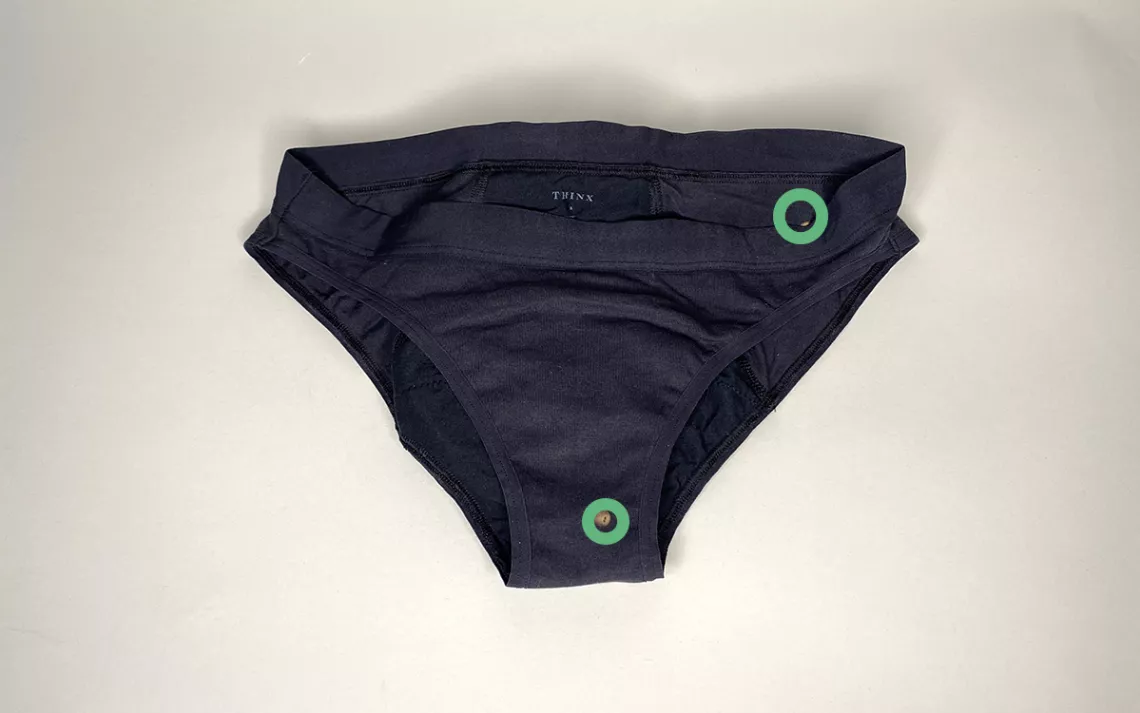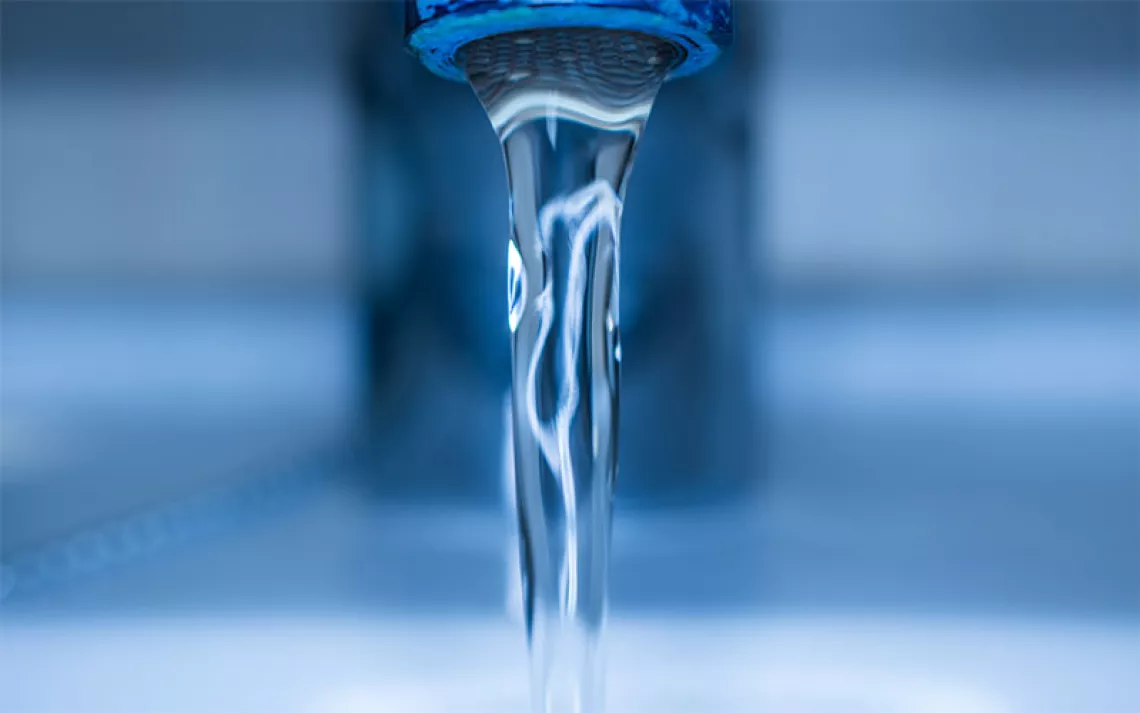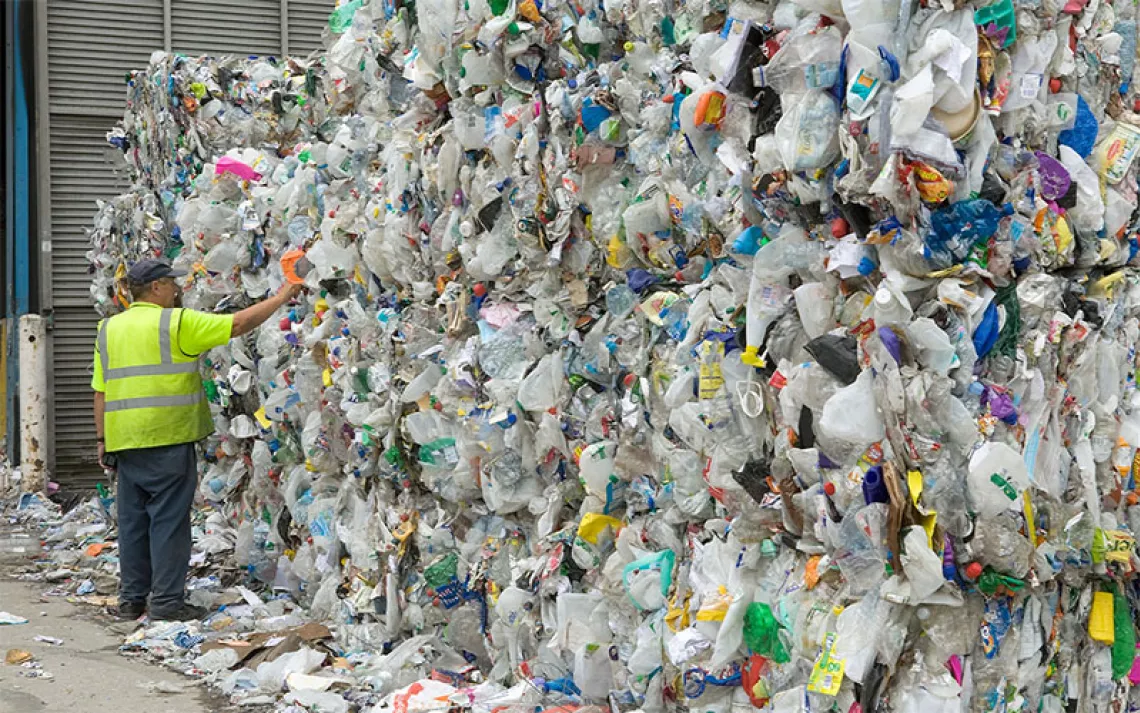What You Need to Know About “Nontoxic” Menstrual Underwear
Five “brief” steps for safer products

Green circles indicate where Graham Peaslee's team performed PIGE and PIXE tests. | Photo by Sam Murphy
In January, I told you about how I mailed my Thinx menstrual leak-proof underwear to professor Graham Peaslee, a nuclear physicist at Notre Dame University. In an independent test, his team found toxic chemicals, including PFAS. PFAS is a class of chemicals, some of which have been linked to serious health impacts like cancer. (PFAS have been found in drinking water, and typical water purifiers do not remove them.) They never degrade. And PFAS have been found to migrate from waterproof textiles into laundry wash water.
The inside of the crotch in my organic bikini had thousands of parts per million (3,264 ppm), and organic Shorty for teens had 2,053 ppm, according to Peaslee’s particle induced gamma ray emission (PIGE) spectroscopy test. That’s high enough to suggest that, whether Thinx intended it or not, PFAS ended up in the products over the course of their manufacturing process. We asked Peaslee to test just one sample (what I sent him), and while his test result was limited to just that one sample, the level of PFAS he found would not be possible from mere incidental contamination, according to Peaslee. He also found that my Thinx organic underwear, the organic one for teens, and the nonorganic Super Hiphugger had tens to hundreds of ppm of copper on the inside crotch and zinc on both sides.
Originally, I didn’t want to test my Thinx underwear. I’d used it since 2016, even though I knew PFAS are in almost everything that’s nonstick and stain-, water- and grease-resistant. But I couldn’t in good conscience answer a question from a reader on eco menstrual products without finding out if my Thinx was PFAS-free. I also sent my menstrual underwear out for independent testing because I couldn’t get Thinx to respond to my emails, the first of which I sent in July 2019, about its testing methods and how it verifies the green claims it makes about its products. Even after I emailed a summary of Peaslee’s results—which were alarming—to Thinx, I still couldn’t get a response.
Within a week of the publication of my article, many of you asked Thinx to post independent lab tests and certificates from its third-party certifiers. Thinx listened to you and to me and finally posted certificates (as well as emailed them to me directly) on January 14, 2020.
Then many of you got confused, and rightfully so. Thinx emailed me 17 certificates and test results from Bureau Veritas along with OCS and GOTS ecolabels, and posted 16 showing that its products were PFAS-free. That doesn’t square with the results I got back from Peaslee in October and November 2019, which showed that, at least in the two pairs of organic underwear I mailed to him, there were high levels of PFAS, especially on the inside layers of the crotch.
So why the discrepancy?
Part of the answer lies in the fact that there are upwards of 5,000 types of toxic PFAS chemicals used in manufacturing. The question is, when Thinx tested for PFAS, did its third-party certifiers test for just a few of those 5,000 chemicals or all of them? How does its testing protocol measure up to Peaslee’s?
Peaslee’s PIGE test measures the presence of fluorine, which is used as a surrogate for PFAS. Bureau Veritas only tested Thinx products for chemicals of “high concern,” most of which should not be in textiles in the first place. It includes some PFAS, namely the C8 - C14 perfluoro carboxylic acids, the C6 perfluoro sulfonic acid, and HFPO-DA. These are all highly bio-accumulative, and none except perhaps PFOA (the C8) would be expected in textiles anymore. Bureau Veritas did not test for short-chain PFAS, which include C6 and C4 acids, and C4 sulfonic acid. It also did not test for copper or for zinc oxide nanoparticles; Peaslee did.
Like many people commenting online, I also wondered why Thinx didn’t post certificates going back to January 2018, which was what I asked for.
On February 6, 2020, in a post on Medium, Thinx CEO Maria Molland cited a toxicologist from Intertox saying that Peaslee’s PIGE test “only indicates the presence of elemental fluoride—not PFAS. Fluoride is a common salt that’s in everyday products like toothpaste. All of us carry fluoride around in our bodies and secrete it through things like blood and sweat. The presence of fluoride doesn’t mean something contains PFAS; what it does mean is that some time in the history of the sample, it came into contact with one or more of any number of products containing fluoride.”
Peaslee’s PIGE method tests for fluorine, not fluoride. PFAS molecules contain fluorine, which is why Peaslee tested for it. A look at Thinx's patent offers some clues, as it says its products “may be treated with . . . polyfluoroalklylacrylates.” Those are fluoropolymers that would give the big fluorine signal Peaslee found and potentially shed short-chain PFAS over time and wear. Even if I had somehow mailed soiled, fluoride-toothpaste-stained underwear to Peaslee, he told me he wouldn’t have found thousands of ppm of fluoride in them. Also, I had Thinx’s Shorty and Super Hiphugger mailed direct from Thinx to Peaslee.
It’s worth noting that Thinx’s toxicology firm, Intertox, was a paid consultant to the Perchlorate Study Group (PSG)—defense contractors with an interest in using perchlorate for rocket fuel, which tainted drinking water across the United States. Intertox rewrote an article before it appeared in a national scientific journal and deleted perchlorate’s harmful health impacts. Also, Intertox founder and director, Dr. Richard Pleus, served as a spokesperson on behalf of the Council on Water Quality—a group funded by Lockheed Martin, Aerojet, Tronox, and American Pacific Corporation—in these companies’ efforts to influence the EPA’s health standards for perchlorate.
In February, I followed up with Thinx for more information about its testing protocols as well as to notify it about the history of Intertox’s involvement with the Perchlorate Study Group. Molland responded by email on February 19, saying, "Prof. Peaslee’s testing was conducted on a limited sample, and the methods he used are unable to directly detect PFAS, or distinguish fluorine from PFAS or other fluorine-containing chemicals. Simply put, his results do not show PFAS in our products. This fact has been confirmed by Dr. Chris Mackay, a respected senior managing toxicologist at Intertox, who was not involved in the work conducted by other Intertox toxicologists on behalf of the Perchlorate Study Group, any of its member companies with regards to perchlorate, or the Council on Water Quality. Dr. Mackay reviewed Prof. Peaslee’s test results and analyzed our products and other testing conducted by well-established institutions.” She continued, “The implication that Thinx products have negative health effects connected to PFAS is unsubstantiated—and the continued reporting of this narrative does a disservice to people seeking out safer alternatives to traditional period products."
Unfortunately, we don’t have a regulatory regime in this country to force companies to employ the kind of rigorous testing that Peaslee used on my Thinx underwear. The EPA only required safety testing for 0.25 percent of 80,000 synthetic chemicals registered with the EPA since 1976. It’s unclear how many chemicals are in use, because the US Toxic Substances Control Act (TSCA) does not require comprehensive reporting.
I also found that for independent consumers, it’s very hard to test for PFAS. In February, I tried to find another lab and get a new pair of Thinx and other brand products tested. Vista Analytical Laboratories uses a different test method: liquid chromatography–mass spectrometry (LC/MS/MS) digest and analysis. But the National Environmental Laboratory Accreditation Program (NELAP) accredits labs like Vista to do LC/MS/MS tests only for up to 41 of the 5,000 PFAS for solid materials. (The EPA only has a test method for 24 PFAS.) And Vista Analytical couldn’t test for acrylates like the ones in Thinx’s patent. Total fluorine tests like Peaslee’s are still a better way to detect PFAS.
But there’s hope! Within two weeks of the publication of my article, Thinx’s competitors heard you and proposed laws to regulate themselves, because there are no consumer safety regulations for period underwear and no universal testing standards to verify product claims.
We can demand that and more. Here are five steps you can take to protect yourself:
1. Contact your Congress member to support
- TSCA reforms like these from the Natural Resources Defense Council
- The PFAS Action Act (HR 535), which would designate PFAS as hazardous, add PFAS to the Clean Air Act, and authorize millions of dollars for research and water treatment
2. Ask ecolabels to post online what they verify in certified products (their full standard), not just a short description. It’s usually many pages long and should include their restricted substances list (RSL) of what shouldn’t be in certified products. OEKO-TEX didn’t list its standard on its website, so I had to request it by email. Sometimes you have to pay ecolabels just to see their standard.
3. In order to ensure an ecolabel or law is actually protecting you, read its standard to check for:
- Disincentives: Are there any? Are they high enough for people who don’t comply?
- Ingredients: Do they require manufacturers to disclose all ingredients, even treatments added to textiles?
- Enforceability and enforcers: Who will enforce it, and do they have the will, time, and money, and no conflict of interest? How often does the enforcer do surprise spot checks?
4. If you see green claims like the ones below, you can report them to the US Federal Trade Commission (FTC):
- “Free of.” Companies shouldn’t say that if it’s not true.
- “Nontoxic.” Companies shouldn’t say that unless they have scientific evidence that a product is safe for both people and the environment.
5. Also, ask your Congress members to require government and ecolabels such as Organic Content Standards (OCS), Global Organic Textile Standard (GOTS), and OEKO-TEX to conduct these tests:
- Total fluorine test (such as Peaslee’s PIGE test)
- X-ray analyses for heavy metals (such as Peaslee’s PIXE test), including on added water- or stain-resistant treatments
Want safer products? Tag me @realMsGreen with #RealGreenProducts when you ask the US FTC, any state attorney or consumer protection law firm, manufacturer, ecolabel, or Congress member to try any of my five tips!
 The Magazine of The Sierra Club
The Magazine of The Sierra Club



